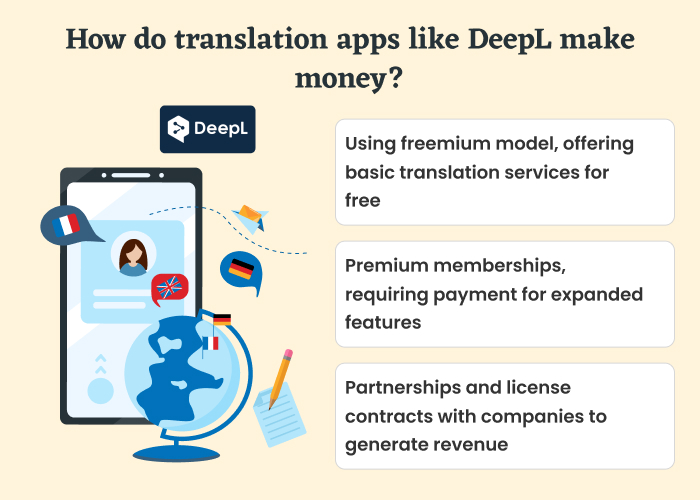What are the factors that affect the cost of developing language translation apps?
Developing a language translation app involves various factors that can influence the overall cost of development. Here are some key factors that affect the cost:
- The intricacy of the features you wish to incorporate into the application has a big influence on development expenses. More complex functions like voice input/output, text-to-speech, offline mode, real-time translation, and language identification will cost more money than basic translation functionality.
- The cost of development is directly impacted by the number of languages your app will support. It takes more resources to handle more languages, including language models, translation databases, and APIs and services integration.
- The cost is also influenced by how complicated the user interface design is. A more complex and aesthetically pleasing design with unique animations and interactions will cost more money and take more time to create than a simpler, more direct design.
- To guarantee the translation app’s dependability and correctness, extensive testing is necessary. Writing test cases, doing manual and automated testing, and making sure the product is compatible with a variety of hardware and operating systems are all included in the testing cost.
How do translation apps like DeepL make money?

There are several ways that translation apps such as DeepL, make money to maintain their services and encourage further development.
- Apps that provide translation services, such as DeepL, have a freemium business strategy that makes the app available to a larger user base by granting free access to basic translation services.
- Furthermore, they frequently include premium membership plans that require user payment in order to access expanded functionality and features. These plans provide limitless text translation and document translation among other perks.
- Partnering with companies, organizations, or language service providers and signing license contracts bring in money. These collaborations and agreements provide access to the app’s technology or customized solutions.
What are the ways to monetize translation apps?
Translation applications may be made profitable in a variety of ways, based on their capabilities, intended user base, and business strategy. The following are a few typical monetization techniques:
- Freemium Model: Offer a free version of the app with basic translation features and limited language support. Users can then upgrade to a premium version to unlock additional languages, advanced features, and an ad-free experience.
- Subscription Model: Implement a subscription-based model where users pay a recurring fee to access premium features and language packs. Subscriptions can offer tiered pricing with different levels of functionality to cater to different user needs.
- In-App Purchases: Offer in-app purchases for premium features, additional language packs, or ad removal. Users can purchase these items directly within the app to enhance their translation experience.
- Ads: Display advertisements within the app to generate revenue. You can use various ad formats, such as banner ads, interstitial ads, or rewarded ads, depending on user engagement and preferences. However, be mindful of the impact on user experience and ensure ads are not overly intrusive.
- Affiliate Marketing: Partner with language learning platforms, travel booking websites, or e-commerce sites that target international audiences. You can earn commissions by promoting relevant products or services to your users through affiliate links or referral programs.
- Sponsorships: Collaborate with language schools, travel agencies, or international organizations to offer co-branded experiences, exclusive discounts, or sponsored content. Partnerships can provide additional revenue streams and help expand your app’s user base.
Conclusion
In conclusion, creating language translation apps might be difficult and expensive, but there are many ways to monetize it, so it can be a successful project. Developers and company owners may choose the best monetization tactics to earn cash while offering value to users by taking into account many elements such as the app’s functionality, target demographic, and business model. In today’s globalized world, translation apps have the potential to be profitable investments through several means such as subscription models, in-app purchases, collaborations, or adverts.
FAQs
How do translation apps ensure the accuracy of translations?
Can translation apps translate complex technical or specialized content?
Are translation apps suitable for professional use in industries such as legal or medical?
How do translation apps handle regional dialects or variations in language?
Can translation apps translate handwritten or scanned text?
Ravi Bhojani is the Chief Marketing Officer (CMO) at Alian Software, where he spearheads the company’s marketing strategies and drives its brand presence in the competitive IT services landscape. With over a decade of experience in the technology and marketing sectors, Ravi has consistently demonstrated his ability to blend innovative marketing techniques with deep industry knowledge to deliver outstanding results.